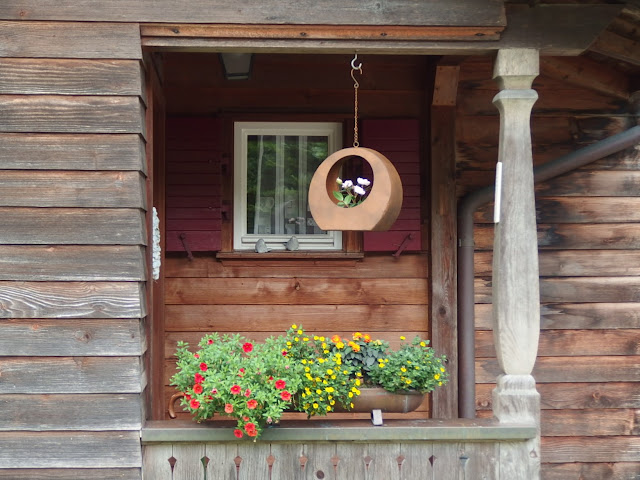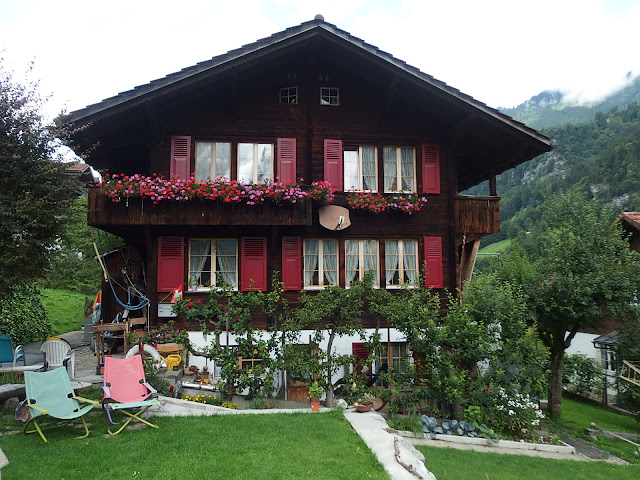Weekend Wandering: Gardens, the Swiss Alpine way
You may have guessed already that I loved our holiday in Switzerland. I adored the mountains and their views; the clean air; and the beauties of nature ready for us to drink in and admire.
My garden blogger antennae were also finely tuned to pick up anything of a garden nature and I was surprised to find a distinct style throughout every village, which in turn formed its own backdrop to our visit. It was a complete contrast to the more eclectic and individual style I see from the train in the UK.
The first feature I noticed were the window boxes on every chalet crammed with cheerful pelargoniums. Most of these were red, as if there was an unspoken rule on what a windowbox should contain.
It was good to see there were others willing to flout this 'rule'. I'd say pink was the next choice, followed by white. It was clear the Swiss love to have plenty of colour in their gardens. An antidote to the white of winter perhaps?
I was also pleased to see lots of apple trees, though trained forms like the ones seen in the above photo were rare. They were mostly small, winter hardened and architectural trees, with a promising crop of small fruit reddening in the sun. A lawn with loungers was rare too, which makes me think this may have been a holiday chalet.
Alpine gardens are tiny and mainly to the front. I imagine the soil there is probably quite hard to work and besides, any alpine farmer is going to dedicate as much land as possible for hay making to help their cattle through the winter. We saw in my previous post how the land management practices have led to their own 'garden' style with species rich meadows full of jewel-like wildflowers. With those stretching up the mountains as far as the eye can see, who needs a large garden anyway?
Some owners also had a tiny vegetable patch to the side or behind their property. Most had cheerful blooms in the mix and I spotted lettuces and leeks as the most popular crops. One notable exception was the squash romping away on the top of a large compost heap, but it was too far away for me to photograph from the train.
It seems the Swiss extend their gardens into their cemeteries if this one in Lauterbrunnen is anything to go by. I thought it was charming and quite different to the many overgrown churchyards I've seen in the UK. I wonder if this shows most Swiss families tend to stay where they are, and so can look after the graves of their loved ones?
A day in Bern showed they like pelargoniums too, with much of the architecture in the centre of the city echoing in stone the wooden chalets of the mountains.
And finally, a find in Lauterbrunnen with a Friday Bench which made my heart sing.
Update: a wonderful insight from Diana in the comments on what happens at Swiss cemeteries, which I simply had to share:
"My husband's aunt lies there with her husband. In Switzerland you have the grave for 20? years. Then can choose to pay to keep it for another 20, so each generation chooses which graves the descendants want to care for. The graves you see are all cared for by the living, cherishing memories. When we walked there we met his cousin, who was on a daily visit to his wife's grave."


















The cemetery is so cool and I love the window boxes
ReplyDeleteThey are both wonderful. People tend to put fresh flowers on graves over here, and they can look a bit of a sorry sight. I like the act of tending the grave shown here and it's shown me again that taking cuttings from mum's funeral flowers was the right thing to do.
DeleteI've seen cemeteries like that in Germany, too -- totally amazing. And I love all the Pelargoniums in windowboxes...
ReplyDeleteThat's interesting Lisa, I wonder if it's the same in Austria too.
DeleteLovely post and pictures. The cemetery picture is wonderful. xx
ReplyDeleteThanks Flighty, have a great week!
DeleteMy husband's aunt lies there with her husband. In Switzerland you have the grave for 20? years. Then can choose to pay to keep it for another 20, so each generation chooses which graves the descendants want to care for. The graves you see are all cared for by the living, cherishing memories. When we walked there we met his cousin, who was on a daily visit to his wife's grave.
ReplyDeleteSuch a different and better way than ours - where the cemeteries are not visited and the land in the city is 'wasted'.
Thanks for the insight Diana and that's marvellous. Sadly many of the UK's graveyards are as you describe for South Africa. We live so far away from our families' origins and so can't tend them apart from an annual visit. I wonder what happens in Switzerland after the 20 years is up and the option for a further 20 years isn't taken?
DeleteYou can see the answer to your question in your photo. The rolling green lawns. Gravestones removed, and the land left to lie fallow ... till it is needed for fresh graves. The newest graves have wooden crosses till the land has settled.
DeleteIt was a culture shock to me. Also the annual visit on All Saints to replant the grave.
Ah yes, I see. I had wondered why there was so much lawn, especially when compared to our stuffed graveyards in the UK. That makes sense, and as you say quite a different approach. Thanks for adding your further insight Diana :)
Delete